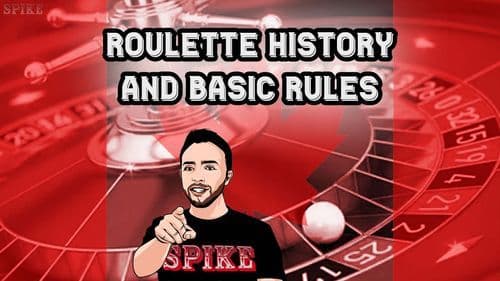Roulette: Historical Background and Basic Rules

Roulette is a table game that originated in France, probably derived from the Italian pastime called Biribi.
In the game, the player has the choice of betting on a single number; various groupings of numbers, whether the number will be even or odd, high (19-36) or low (1-18).
During the round of play, the croupier spins the small wheel in the opposite direction to which he will throw the ball.
The surface where the ball spins is tilted and has a series of baffles that also mark the different numbers.
Eventually, the ball will stop at one of thirty-seven (French or European style) or thirty-eight (American style with double zeros) or thirty-nine, as in the case of Sands Roulette which has triple zeros.
After verifying winnings, these still will be paid out.
The game dates back to the 18th century: indeed, several historians consider Blaise Pascal the inventor of an original form of roulette in the 17th century, while he was creating the prototype perpetual motion machine.
Indeed, the system on which the current play is based would seem to derive from a hybrid mechanism between the Italian Biribi and a small wheel devised in 1720.
Until the late 18th century, in the casinos of Paris the color red indicated the single zero, while black, was the color of the double zero: green to indicate zeros, was introduced in 1800, to avoid confusion.
It would be necessary to wait until the 19th century to observe the spread of this game throughout Europe and the United States.
After the popularity of this entertainment in Europe, specifically in Monte Carlo, single-zero variant was exported all over the world, except in the United States where the double-zero version continued to excel.
The game in the United States
Initially, the double-zero French wheel became popular in Mississippi from New Orleans, later spreading westward.
This variant became well-liked in the gambling dens of the new territories, while the French version progressed by making its way into more elite settings devoted to entertainment, such as the Monte Carlo casino.
And indeed, in the early 20th century, only Monte Carlo with its traditional French single-zero wheel and Las Vegas, with its American double-zero version, were the only cities in the world to offer this play professionally.
But in the 1970s, casinos spread around the world, and in 1996 the first online casino was born.
The prevalence of the double-zero wheel consolidated in the United States, Canada, South America and the Caribbean, while the European version of the wheel spread to the rest of the world.
Structure of the wheel
In spaces 1 to 10 and 19 to 28, odd numbers are red, and even numbers, black.
In contrast, in spaces 11 to 18 and 29 to 36, odd numbers are black, even numbers, red.
One section is green and numbered zero, while as we anticipated, in the American variant we have a second green section marked 00.
This sequence of numbers in the sections, is clockwise in most gaming establishments.
The table on which the system is placed, is usually green and is called the layout.
The European layout obviously has a single zero, while the American-style layout has a double zero.
Typical of Monte Carlo is the layout with a table with a wheel in the center and layout arranged on either side.
Kinds of bets
In Roulette it is possible to place internal and external stakes.
Inside bets
Straight/Single: You bet on a single number by placing the chip in the corresponding box.
Split: Wager on two vertically and horizontally adjacent numbers, for example, 8 and 9.
The chip is placed between the two numbers.Street: You stake on three consecutive numbers in a horizontal line, for example, 7-8-9.
The chip is placed on the outside of the number at either end of the line.Corner/Square: you gamble on four numbers meeting in a corner, for example, 10-11-13-14 and the chip is placed on the corner itself.
Six Line/Double Street: on six consecutive numbers forming two horizontal lines, for example, 31-32-33-34-35-36.
The bet is placed on the outside corner, shared by the two leftmost numbers, or the two rightmost numbers.Trio: gamble of three numbers with at least one zero of the type, 0-1-2; 0-2-3 (European version only); 00-2-3 (American version only).
The chip is placed on the shared corner.First Four: on 0-1-2-3, European layout only.
Basket: on 0-00-1-2-3 double zero layout only.
Outside gambles
Outside bets usually have smaller payouts with better odds of winning.
Commonly these wagers lose if a zero comes out.
1 to 18 (Low or Manque) or 19 to 36 (High or Passe)
Red or Black: (Rouge ou Noir)
Even or Odd: (Pair ou Impair)
Dozen: (on the dozen chosen, 1-12; 13-24; 25-36)
Column: (bet in the chosen vertical column of 12 numbers, such as 1-4-7-10 up to 34)
Snake: a special gamble to cover the numbers 1, 5, 9, 12, 14, 16, 19, 23, 27, 30, 32 and 34.
(It has the same payout as the dozen bet and is named after the zigzag, snake-shaped bet).
Strategies
Throughout the entire history of this play, many have tried to understand ways to beat Roulette and turn it into something profitable.
Most often, these are systems and strategies that see the possibility of winning on the house edge by using special betting patterns.
Although these schemes can bring high winnings, the losses will still outweigh the winnings.
For example, the Martingale is extremely risky: at some point the player may continue to chase losses with larger and larger bets until all the money is used up.
In the Martingale, the player doubles the bet after each loss so that the winnings make up for previous losses.
But since past results do not determine future ones, it can also happen that the player loses several times in a row, and with the doubling of bets, he comes to exhaust all the available budget, thus having big financial damage.
Another tactic is the Fibonacci system, where stakes are calculated according to the Fibonacci sequence.
But none of these strategies can statistically overcome the casino's advantage, so you must keep this in mind.
Final thoughts
In this article we have tried to delve into the history and operation of one of the most popular casino games ever known also in Canada: the Roulette.
In all its versions, this entertainment has been winning over players around the world for centuries.
Although there are strategies to be applied, remember that in the long run it is not possible to beat the house edge.
So, we remember to gamble responsibly and in moderation.









